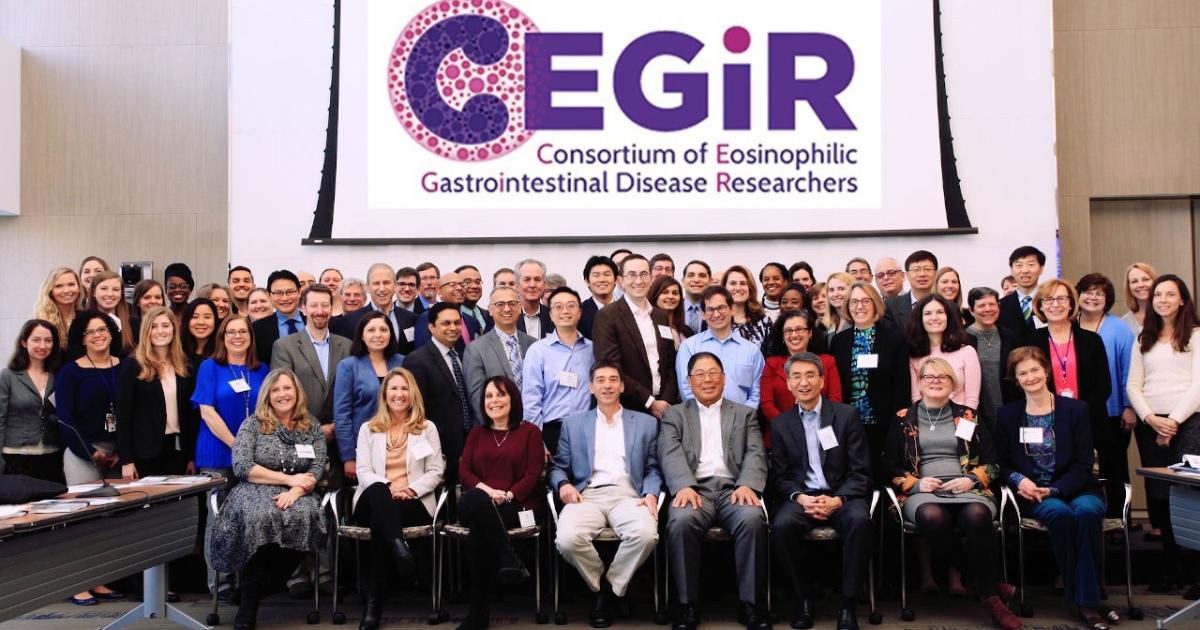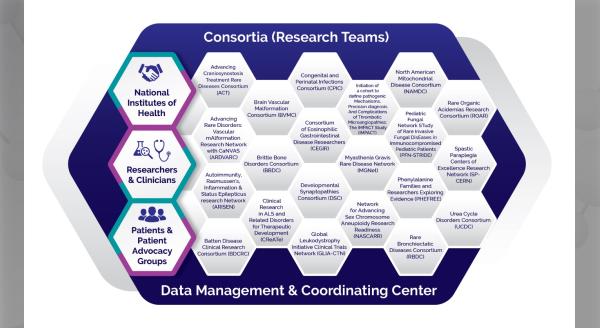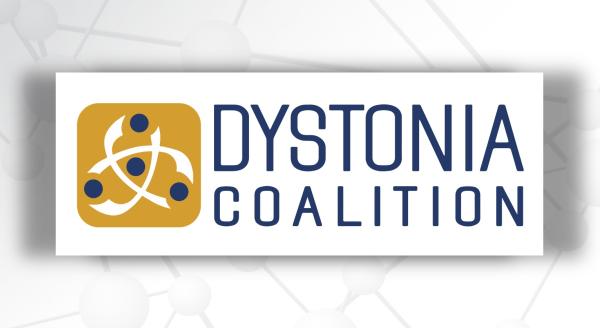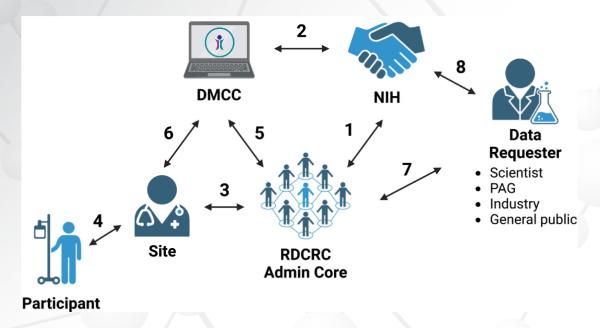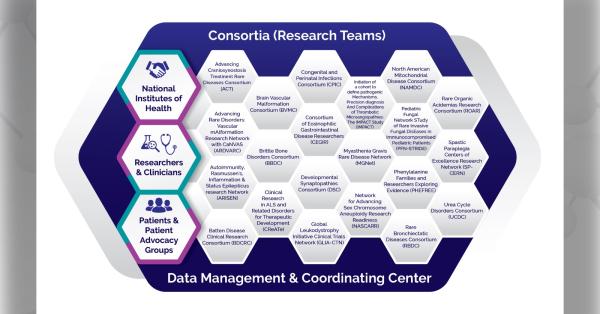A strong collaboration between researchers and patient advocacy groups in the Consortium of Eosinophilic Gastrointestinal Disease Researchers (CEGIR) is demonstrating how partnering with patients can accelerate discoveries for rare diseases. CEGIR is one of 23 active consortia funded through the NIH’s Rare Diseases Clinical Research Network (RDCRN), which supports national teams of researchers, patients, and clinicians—each focused on a set of rare disorders. To win funding, every RDCRN consortium must actively partner with patient advocacy groups. CEGIR’s team includes three main patient advocacy groups (the American Partnership for Eosinophilic Disorders, Campaign Urging Research for Eosinophilic Diseases, and the Eosinophilic Family Coalition) with 11 patient advocacy groups in total.
Around the world, researchers are studying eosinophilic gastrointestinal disorders. They search for answers in statistics, outcomes, and medical literature.
Around the world, individuals are living with these rare diseases. They experience first-hand symptoms, treatments, and challenges.
What if these researchers and patients were no longer worlds apart?
The Consortium of Eosinophilic Gastrointestinal Disease Researchers (CEGIR) is beginning to answer this question. As researchers partner with patients, scientists learn more about eosinophilic gastrointestinal disorders from the people who live with them every day—leading to better treatments and progress toward a cure.
Understanding eosinophilic gastrointestinal disorders
“Patient involvement in research is extremely valuable because it allows researchers to understand the human side of a disease.”
—Amy Zicarelli, Support Group Leader for the Eosinophilic Family Coalition (EFC)
Eosinophils are disease-fighting white blood cells that are typically associated with allergic reactions and infections. Food and airborne allergens can trigger the body to overproduce eosinophils, resulting in chronic inflammation and tissue damage. When too many eosinophils accumulate in the digestive system, this is called an eosinophilic gastrointestinal disorder (EGID).
Life with EGIDs differs for each patient—there are several types, depending on where the elevated levels of eosinophils are found—but common symptoms involve difficulty eating and swallowing. Patients may need to puree, chew slowly, or altogether avoid certain types of food. They often experience nausea, vomiting, stomach or chest pain, and reflux that doesn’t respond to anti-acid medications.
As these symptoms can be indications of more common health issues, EGIDs are often underdiagnosed. Many patients endure years without appropriate treatments.
“Because EGIDs are rare, they can be difficult to detect, monitor, and manage,” says Marc Rothenberg, MD, PhD, of Cincinnati Children’s Hospital Medical Center and Principal Investigator of CEGIR. “For individuals affected by EGIDs, this could result in unique barriers to care and complex unmet needs.”
In order to address these needs, researchers must learn—what is it like to live with EGIDs? Only the patients themselves can provide answers.
“Patient involvement in research is extremely valuable because it allows researchers to understand the human side of a disease,” says Amy Zicarelli, support group leader for the Eosinophilic Family Coalition (EFC). “Learning about daily life with a disease gives a whole new perspective. When researchers begin to understand the challenges at hand and the symptoms faced, it often leads to new questions and discoveries.
Shaping the Research
“We feel included in every aspect of CEGIR, from the very first conference call to the first clinical trial—which was a study on the food elimination diet. When we shared our viewpoint, they changed their direction based on our feedback. They asked for our perspective because they care and believe that we have valuable knowledge.”
—Ellyn Kodroff, President, Campaign Urging Research for Eosinophilic Disease (CURED) Foundation
For new discoveries to become a reality, the EGID community knew they would need to collaborate and move forward together—but access can be challenging when it comes to rare diseases. Scientists, health care providers, patients, and patient advocacy groups all hold important pieces of the puzzle. How could they combine to form a complete picture?
Researchers and patient advocacy groups decided to partner on a grant application to join the Rare Diseases Clinical Research Network (RDCRN). The patient advocacy groups helped to propel this effort by writing letters of support, surveying patients on research interests, and even authoring sections of the grant application.
The hard work paid off—in 2014, CEGIR won RDCRN funding and established itself as the first multicenter clinical research program focused on EGIDs.
“Involvement in the RDCRN has been critical for moving EGIDs research forward,” says Seema Aceves, MD, PhD, of the University of California, San Diego; Rady Children’s Hospital-San Diego; and a CEGIR Site Leader. “It has allowed for the integration of multiple clinical sites to conduct trials and to interact on a regular basis. It has also created the necessary platform for systematic data capture.”
With greater interaction and streamlined data, CEGIR is able to advance research faster than ever before. Resources are now available to study all facets of EGIDs, from clinical, social, and financial to diagnostic criteria, disease pathogenesis, and treatment regimens. Fourteen participating clinical sites partner with three primary patient advocacy groups to ensure that patients are at the center of it all.
“We feel included in every aspect of CEGIR,” says Ellyn Kodroff, president of the patient group Campaign Urging Research for Eosinophilic Disease (CURED) Foundation, “from the very first conference call to the first clinical trial—which was a study on the food elimination diet. When we shared our viewpoint, they changed their direction based on our feedback. They asked for our perspective because they care and believe that we have valuable knowledge.”
Supporting the Research Process
“By organizing focus groups, tailoring recruitment materials for specific platforms, and distributing information about CEGIR studies, we empower patients to make their voices heard.”
—Mary Jo Strobel, Executive Director, American Partnership for Eosinophilic Disorders (APFED)
Although patients are essential to research success, it isn’t always easy for researchers to find and connect with them. Clinical trials have unique participation criteria that narrow the pool of eligible patients in an already narrow field of EGIDs patients. Even if a patient does qualify, they may be unable to travel to an enrollment site or feel uncomfortable participating in research.
This is where patient advocacy groups can support the research process by identifying participants, explaining the research, and conveying its importance.
“We create opportunities for patients to be involved and boost recruitment for a number of research initiatives,” says Mary Jo Strobel, Executive Director of the American Partnership for Eosinophilic Disorders (APFED). “By organizing focus groups, tailoring recruitment materials for specific platforms, and distributing information about CEGIR studies, we empower patients to make their voices heard.”
Opportunities to participate in research go far beyond clinical trials—patients can join contact registries, complete surveys, attend conferences, and raise funds for research efforts. Patient advocacy groups utilize newsletters and social media communication to ensure that these initiatives are accessible to everyone.
The impact of this participation shows through all that CEGIR has accomplished. In addition to advancing the basic understanding of the disorders, CEGIR is training the next generation of experts, investigating new diagnostics and therapeutics, and moving closer to a cure every day.
“There is no greater time than now for research in EGIDs,” says Zicarelli. “In the end, it’s all about faster diagnosis and better treatments for patients—and that’s what CEGIR is doing.”
Visit the CEGIR website to learn more. To hear more stories about patient engagement in research, visit the Rare Diseases Clinical Research Network (RDCRN) during Rare Disease Day at the NIH on February 28 and follow our social media hashtags #RDCRNPatientPartners and #RDDNIH.
Article written by Dakota Campbell, Division of Biomedical Informatics, Cincinnati Children’s Hospital Medical Center

